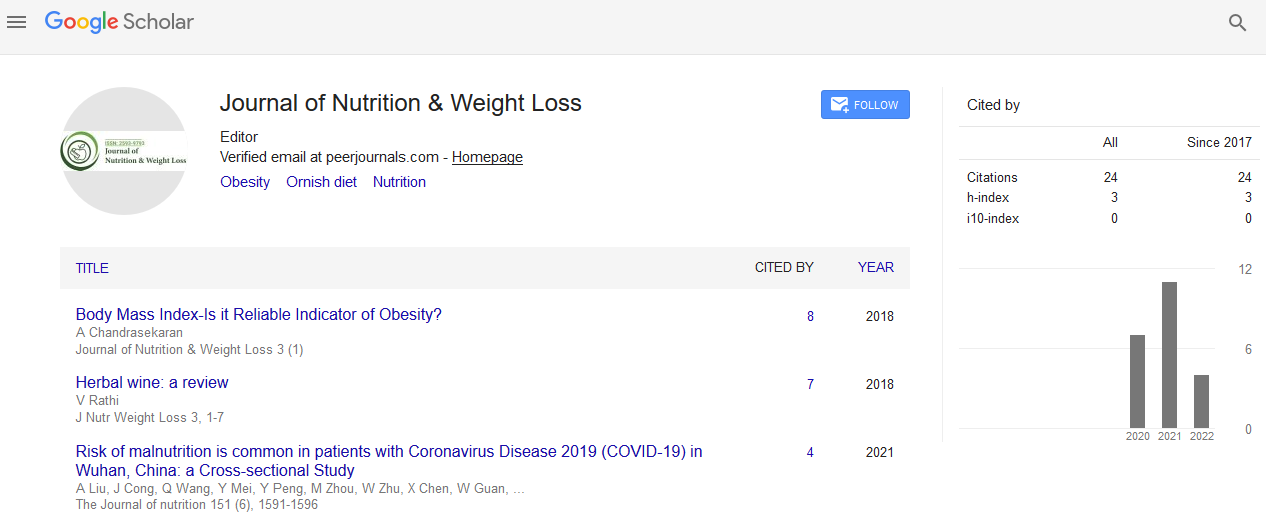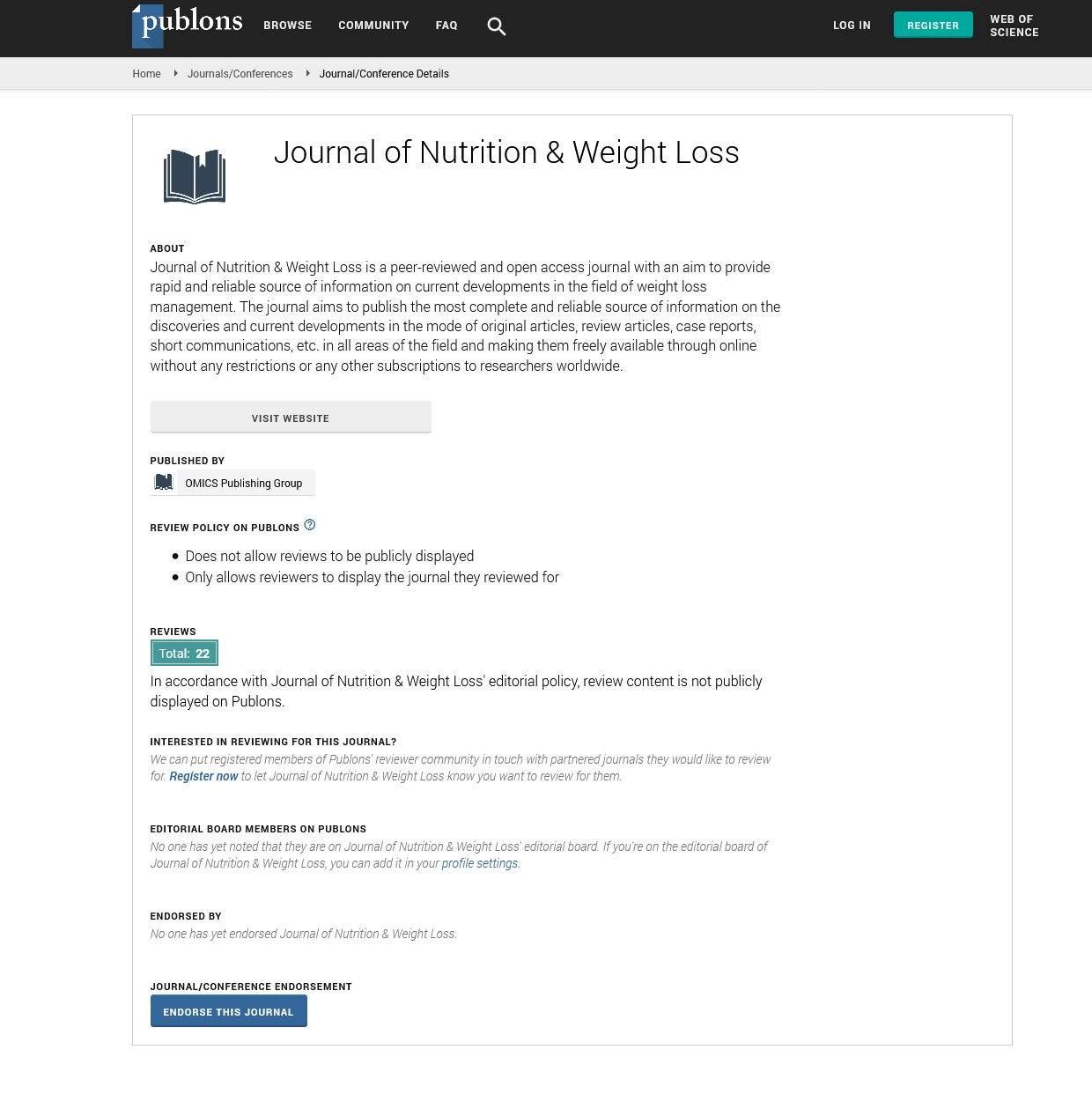Indexed In
- RefSeek
- Hamdard University
- EBSCO A-Z
- Publons
- Euro Pub
- Google Scholar
Useful Links
Share This Page
Journal Flyer

Open Access Journals
- Agri and Aquaculture
- Biochemistry
- Bioinformatics & Systems Biology
- Business & Management
- Chemistry
- Clinical Sciences
- Engineering
- Food & Nutrition
- General Science
- Genetics & Molecular Biology
- Immunology & Microbiology
- Medical Sciences
- Neuroscience & Psychology
- Nursing & Health Care
- Pharmaceutical Sciences
Commentary - (2025) Volume 10, Issue 1
Intermittent Fasting for Health and Weight Management
Chen Leng*Received: 21-Dec-2023, Manuscript No. JNWL-23-24493; Editor assigned: 23-Dec-2023, Pre QC No. JNWL-23-24493; Reviewed: 06-Jan-2024, QC No. JNWL-23-24493; Revised: 18-Jan-2025, Manuscript No. JNWL-23-24493; , DOI: 10.35248/2593-9793.25.10.227
Introduction
Intermittent Fasting (IF) has emerged as a popular and compelling approach to weight management and overall health in recent years. This dietary strategy involves alternating periods of eating and fasting, focusing more on when you eat rather than what you eat. While intermittent fasting has gained significant attention, it is essential to explore its origins, various methods, potential benefits, and considerations for its implementation. In recent years, researchers and health enthusiasts have revisited the concept of fasting, not just as a religious or cultural practice but as a potential strategy for promoting health and well-being. The resurgence of interest in intermittent fasting has led to numerous scientific studies examining its effects on metabolism, weight loss, and various health markers.
Description
Methods of intermittent fasting
The 16/8 method (Time-restricted eating): This method involves fasting for 16 hours each day and restricting your eating to an 8-hour window. For example, you might eat between 12:00 pm and 8:00 pm, fasting from 8:00 pm to 12:00 pm the next day.
Alternate-day fasting: In this approach, individuals alternate between days of regular eating and days of significant calorie restriction or complete fasting.
The 5:2 diet: Participants follow a regular eating pattern for five days of the week and consume a very low-calorie intake (around 500-600 calories) on two non-consecutive days.
Eat-stop-eat: This method involves a 24-hour fast once or twice a week, where individuals abstain from food from dinner one day to dinner the next day.
Warrior diet: This approach involves eating small amounts of raw fruits and vegetables during the day and having one large meal at night, typically within a 4-hour eating window.
Benefits of intermittent fasting
Weight loss and fat loss: Intermittent fasting can be an effective strategy for weight loss. By restricting the eating window, individuals often consume fewer calories, leading to a caloric deficit and subsequent weight loss. Additionally, fasting periods may enhance fat burning as the body utilizes stored fat for energy during the fasting state.
Improved metabolic health: IF has been linked to improvements in insulin sensitivity, which is crucial for maintaining stable blood sugar levels. Enhanced insulin sensitivity can lower the risk of type 2 diabetes and metabolic syndrome.
Cellular repair and autophagy: Fasting triggers a process called autophagy, wherein the body cleans out damaged cells and regenerates new, healthy ones. This cellular repair mechanism is believed to contribute to overall longevity and reduced risk of various diseases.
Heart health: Some studies suggest that intermittent fasting may have positive effects on heart health by reducing risk factors such as cholesterol levels, blood pressure, and triglycerides.
Brain health and cognitive function: Fasting may support brain health by promoting the production of Brain-Derived Neurotrophic Factor (BDNF), a protein associated with cognitive function, learning, and memory. Some animal studies also suggest that intermittent fasting could protect against neurodegenerative diseases.
Inflammation reduction: Chronic inflammation is implicated in various health conditions, including cardiovascular disease and certain cancers. Intermittent fasting may help reduce inflammation in the body, contributing to overall health.
Individual variability: Responses to intermittent fasting can vary widely among individuals. Factors such as age, gender, activity level, and overall health can influence how the body responds to fasting.
Conclusion
Intermittent fasting has gained widespread popularity as a flexible and potentially effective approach to weight management and health improvement. While the evidence supporting its benefits continues to grow, it's essential to approach intermittent fasting with a personalized and informed perspective. Consulting with healthcare professionals, especially for individuals with underlying health conditions, is crucial to ensure that intermittent fasting is a safe and suitable option. As research on intermittent fasting progresses, a deeper understanding of its long-term effects and optimal implementation will likely emerge. In the meantime, individuals interested in exploring intermittent fasting should do so with mindfulness, considering their unique health circumstances and consulting with healthcare providers to make informed decisions about incorporating this dietary strategy into their lives.
Citation: Leng C (2025) Intermittent Fasting for Health and Weight Management. J Nutr Weight Loss. 10:227.
Copyright: © 2025 Leng C. This is an open-access article distributed under the terms of the Creative Commons Attribution License, which permits unrestricted use, distribution, and reproduction in any medium, provided the original author and source are credited.


